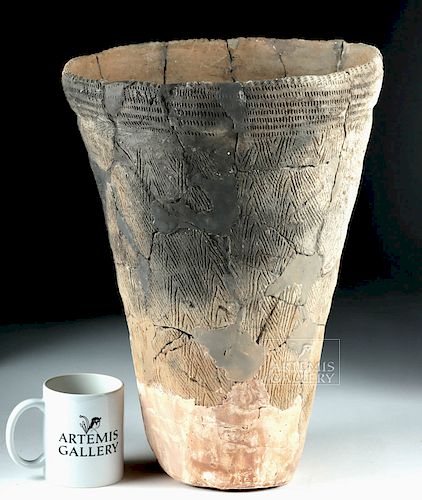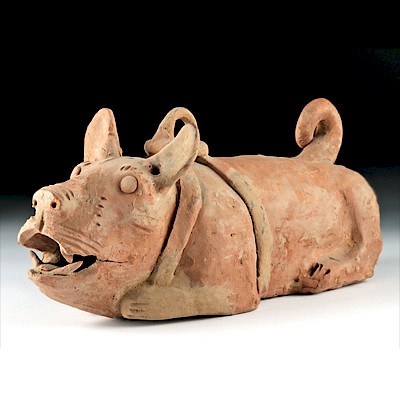Large / Ancient Japanese Jomon Pottery Vessel
Lot 58e
About Seller
Artemis Fine Arts
686 S Taylor Ave, Ste 106
Louisville, CO 80027
United States
Selling antiquities, ancient and ethnographic art online since 1993, Artemis Gallery specializes in Classical Antiquities (Egyptian, Greek, Roman, Near Eastern), Asian, Pre-Columbian, African / Tribal / Oceanographic art. Our extensive inventory includes pottery, stone, metal, wood, glass and textil...Read more
Estimate:
$3,500 - $5,000
Absentee vs Live bid
Two ways to bid:
- Leave a max absentee bid and the platform will bid on your behalf up to your maximum bid during the live auction.
- Bid live during the auction and your bids will be submitted real-time to the auctioneer.
Bid Increments
| Price | Bid Increment |
|---|---|
| $0 | $25 |
| $300 | $50 |
| $1,000 | $100 |
| $2,000 | $250 |
| $5,000 | $500 |
| $10,000 | $1,000 |
| $20,000 | $2,500 |
| $50,000 | $5,000 |
| $100,000 | $10,000 |
| $200,000 | $20,000 |
About Auction
By Artemis Fine Arts
Sep 13, 2018
Set Reminder
2018-09-13 10:00:00
2018-09-13 10:00:00
America/New_York
Bidsquare
Bidsquare : Ancient | Asian | Ethnographic - Fall Variety
https://www.bidsquare.com/auctions/artemis-gallery/ancient-asian-ethnographic---fall-variety-3432
Travel the world and back in time... Antiquities from Egypt, Greece, Italy and the Near East, Asian, Pre-Columbian, African / Tribal / Oceanic, Native American, Spanish Colonial, Russian Icons, Fine Art, much more! Artemis Fine Arts info@artemisfinearts.com
Travel the world and back in time... Antiquities from Egypt, Greece, Italy and the Near East, Asian, Pre-Columbian, African / Tribal / Oceanic, Native American, Spanish Colonial, Russian Icons, Fine Art, much more! Artemis Fine Arts info@artemisfinearts.com
- Lot Description
East Asia, Japan, late Early to Middle Jomon period, ca. 3000 to 2000 BCE. A large, deep, conical urn made using the coiling method, the clay mixed by the woman who made it (women produced all ceramics in this culture) with adhesive materials like mica, lead, fibers, and crushed shells. She would then smooth the interior and exterior and create cord-like motifs around the exterior, many of which can still be seen here, and for which this enigmatic culture is named - "Jomon" means "cord pattern" in Japanese. On this interestingly-decorated example, the lower body is decorated with a different pattern than the rim. Jomon pottery is some of the oldest ever made, and much of it has a similar form as this example: "fukabachi," deep bowls or jars. The flattened base indicates that it is probably from the Early period or beginning of the Middle Jomon period. Size: 12.05" W x 16.7" H (30.6 cm x 42.4 cm)
The fukabachi style emerged at the beginning of the Jomon period and persisted for centuries. These were used for cooking and storage; the cultivation of rice, which began around this time, created demand for ceramic domestic vessels. People lived in small communities, in square-shaped pithouses and had regular trade with the Korean peninsula and with each other, creating a fairly uniform ceramic tradition across a wide geographic area.
Provenance: private Chicago, Illinois, USA collection
All items legal to buy/sell under U.S. Statute covering cultural patrimony Code 2600, CHAPTER 14, and are guaranteed to be as described or your money back.
A Certificate of Authenticity will accompany all winning bids.
We ship worldwide and handle all shipping in-house for your convenience.
#134889Extensively repaired with some areas of restoration/new clay and overpainting as shown in the photographs. Approximately 75% original, with motifs still clear.Condition
- Shipping Info
-
All shipping is handled in-house for your convenience. Your invoice from Artemis Gallery will include shipping calculation instructions. If in doubt, please inquire BEFORE bidding for estimated shipping costs for individual items.
-
- Buyer's Premium



 EUR
EUR CAD
CAD AUD
AUD GBP
GBP MXN
MXN HKD
HKD CNY
CNY MYR
MYR SEK
SEK SGD
SGD CHF
CHF THB
THB
















